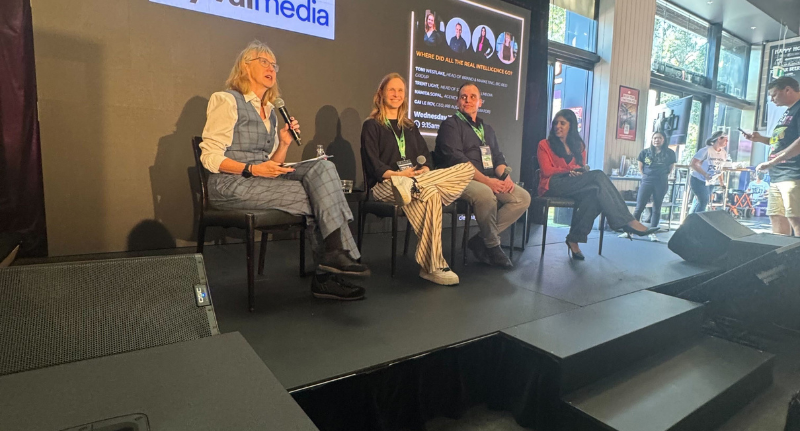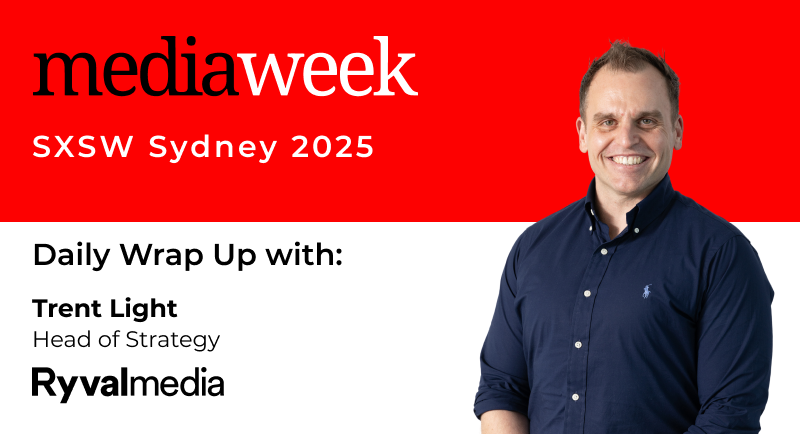Sydney really turned on the weather for day three of SXSW, with the whole precinct buzzing from early in the day.
I started my day at Clear Hayes House, appearing on a panel with the amazing Toni Westlake from Big Red Group and Namita Sopa from Pinterest to talk about how artificial intelligence is only as powerful as the intelligent humans running it.
Gai Le Roy from the IAB was the facilitator, asking probing questions and throwing a few curveballs to keep us on our toes as we discussed why the human brain still rules when it comes to intelligence.

Immediately following that session, I found a spare seat, smashed a few bagels, and heard leaders from The Trade Desk and Foxcatcher debate whether programmatic was broken and, if so, how we fix it.
Understanding programmatic
It was a provocative opening from Karan Kent of Foxcatcher, who mused about the “programmatic utopia” we were all promised. One where clients could reach the right audience at the right time with the right message, deliver greater ROI, and talk to their customers on a one-to-one basis at scale.
But somehow, this promise was lost along the way, in a murky lack of transparency and questionable inventory quality, which led to “programmatic” becoming a dirty word in the industry for some.
Matt Proud from The Trade Desk argued that programmatic doesn’t have a delivery or tech problem; it has a KPI problem. There is still work to be done in educating the industry on the possibilities of programmatic advertising and how it doesn’t just reach your audience, but also creates a feedback loop that helps clients learn about their audience.
Involving your programmatic partners earlier in the process is key to understanding what’s possible, which KPIs we should be optimising for, and how digital budgets are allocated across all platforms.
This collaboration is crucial for solving the trust dilemma. Ultimately, the more the industry understands how programmatic works, the more it will be valued.
Gen Z’s turn away from Google
For the afternoon, I tried to steer myself away from the AI discussion as I was starting to feel my own brain drain in real time.
I leaned more into the creative space, focusing on the instinctive human need for connection and community, rather than on brands trying to insert themselves into every moment of our day.
The “chronically online” gaming influencer Ella Lowgren ran a packed session about creating genuine connections with customers in the attention economy.
While focused more on building a personal community of followers, there were also many lessons for brands within the presentation.
The most important takeaway for marketers was the shifting nature of online search, particularly among younger generations.
While Google is still the king/queen of online search, more Gen Zs are turning to Instagram and TikTok for video content that shows and explains things through short form video, rather than just providing information.
The session also spoke about the need for brands to be consistent with their content and not just show up when they have something to sell.
Maintaining a connection with your audience by adding value to their online interactions is critical to building and maintaining brand trust.
Multicultural Advertising
I ended the day where I started, at Clear Hayes House, with an insightful session led by Andrew Howie of Gallant Collective Advisory about the constantly shifting demographics in Australia.
The title, “Australia’s Not White – So Why Is Your Marketing?” was deliberately provocative but also backed up with hard facts that all marketers need to consider when launching their next campaign.
More than half of Australians were either born overseas or have at least one parent born overseas, and more than 300 different languages are spoken in Australian households.
The session discussed the failure of marketing strategies to evolve alongside these cultural changes, with many growing communities being overlooked or underserved by content and advertising that resonates with them.
The clear takeaway is that multicultural advertising shouldn’t be a secondary thought or an add-on to “do the right thing”, it should be the starting point.
We need to understand that our “audiences” are no longer a homogenous group of people who all think, feel, buy, and interact with brands in the same way. A unified strategy that connects with ALL customers is critical to keeping up with the changing demographics of Australian society.
After a long day, I am going to take a break tonight, watch the latest episode of Task (Amazing show on HBO Max), and reflect on everything I have learned over the last few days.
Tomorrow is my final day at the conference, and I’m already looking forward to the sessions from our friends at News Corp Australia and, of course, Sir Martin Sorrell.


